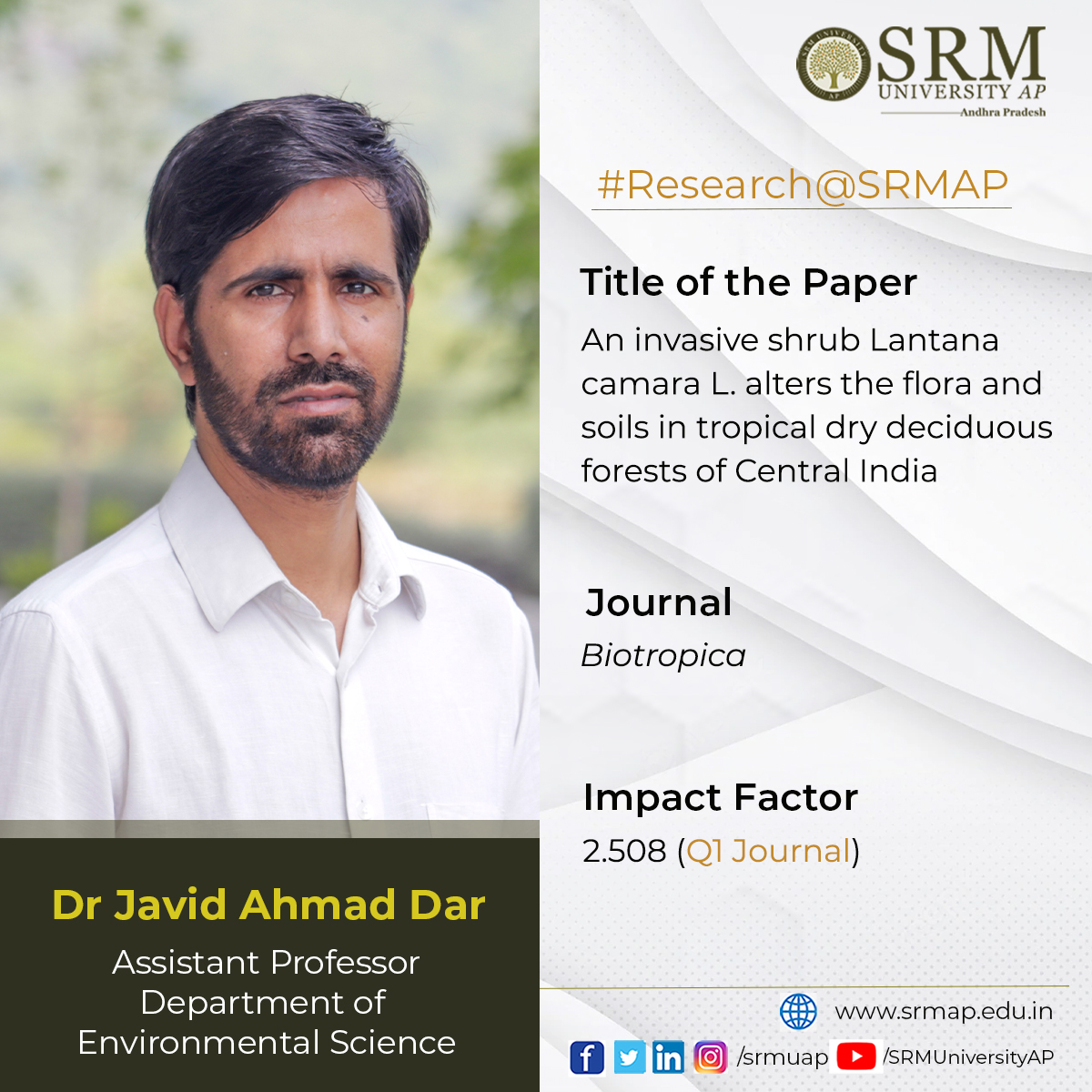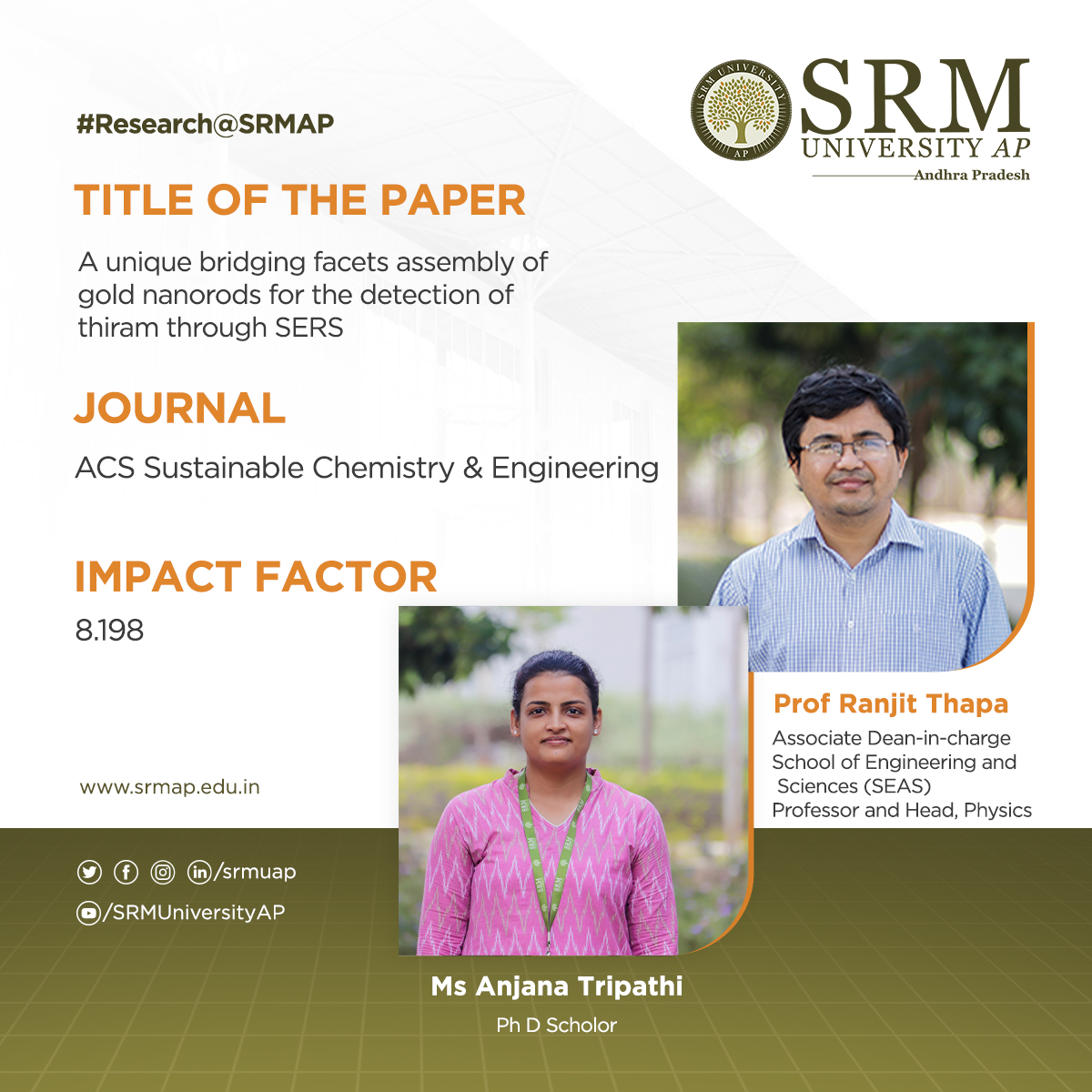- Dr K A Sunitha June 16, 2022
- On an invasive shrub that alters the flora and soils June 16, 2022
 The paper titled “An invasive shrub Lantana camara L. alters the flora and soils in tropical dry deciduous forests of Central India” has been published by Dr Javid Ahmad Dar, Assistant Professor of Environmental Science at SRM University-AP, in “Biotropica” having an impact factor 2.508 (Q1 Journal).
The paper titled “An invasive shrub Lantana camara L. alters the flora and soils in tropical dry deciduous forests of Central India” has been published by Dr Javid Ahmad Dar, Assistant Professor of Environmental Science at SRM University-AP, in “Biotropica” having an impact factor 2.508 (Q1 Journal).Abstract
The findings of this research reveal how an invasive shrub Lantana camara L. significantly alters the flora and soils in tropical dry deciduous forests of Central India and suggested long-term monitoring studies and proper management strategy.
Practical implementation
The findings would be helpful to forest managers, scientists and policymakers for better understanding, management, and restoration of the invaded landscapes in tropical forest ecosystems.
Collaborations
Prof M. L. Khan, Department of Botany, Dr Harisingh Gour Vishwavidyalaya (A Central University), Sagar, Madhya Pradesh, India.
Prof Raman Sukumar, Centre for Ecological Sciences, Indian Institute of Science (IISc), Bengaluru, India.
Prof Mukund Dev Behara, CORAL, Indian Institute of Technology, Kharagpur, West Bengal, India.
Prof S. M. Sundarapandian, Ecology and Environmental Sciences, Pondicherry University, Puducherry, India.Future research plans:
Dr Javid Dar’s research plan for the next five years is to bring together several unique aspects of forest ecology which will be focused on carbon dynamics, mortality, microbial diversity and their relationship in shaping the structure and functional aspects of different forest ecosystems in the on-going and future climate change. Another major aspect of the research will be, to focus on ecophysiology and plant functional trait analysis in forest ecosystems as they are vulnerable to climate change and to see the impacts of climate change on diversity, productivity and stand structure in tropical and temperate forest ecosystems.
Continue reading → - The key to a successful job interview June 16, 2022

Facing an interview is a nightmare for many. There may be multiple factors lowering your level of confidence. Your depth of knowledge, ability to communicate, body language, dressing style, and an endless list of reasons could affect you in being yourself during an interview. While most of us are highly qualified academically, many are still groping in the dark to present ourselves as professionally qualified. And the sad fact is that, it is your professional persona that wins you a better chance of clearing the interview than your academic qualifications.
The Directorate of Alumni Affairs has scheduled a webinar on ‘How to succeed in an Interview’ with our notable alumni, Aayusi Biswas and Tuhin Sarkar from the Class of 2021, Computer Science and Engineering. Aayusi currently holds the position of Associate QA Software Engineer at Sabre Travel Technologies while Tuhin works as a Principal Analyst at AB InBev.
Date: June 18, 2022
Time: 5.00 pm to 6.00 pm IST
The session aims to groom students to give out their best in any interview. Effective training and practice sessions can bridge the gap in one’s academic expertise and career advancement. The more confident you are in being yourself, the better your possibility of winning your dream job.
Register for the session and walk in confidently for all the interviews ahead!
- Fortune India Magazine Publication June 15, 2022
- A unique bridging facets assembly of gold nanorods June 15, 2022
 The paper “A unique bridging facets assembly of gold nanorods for the detection of thiram through SERS” has been published by Prof Ranjit Thapa, Professor of Physics and his PhD student, Ms Anjana Tripathi, in ACS Sustainable Chemistry & Engineering having an Impact Factor of 8.198.
The paper “A unique bridging facets assembly of gold nanorods for the detection of thiram through SERS” has been published by Prof Ranjit Thapa, Professor of Physics and his PhD student, Ms Anjana Tripathi, in ACS Sustainable Chemistry & Engineering having an Impact Factor of 8.198.Abstract
The addition of Au NRs (Gold Nanorods) to TRM (Thiram) of higher and lower concentrations, yields side-by-side assembly (SSA) and bridging facets assembly (BFA), respectively, and exhibited excellent hotspots for the ultra-low detection of TRM. Bridging facets of Au NRs, such as (5 12 0) and (5 0 12) planes are mainly responsible for the BFA. This kind of interaction is observed for the first time and not reported elsewhere. The detailed facets of Au NRs, namely side facets, bridging facets, and pyramid facets, were discussed with the 3D model of Au NRs. The computational studies confirm the SSA and BFA for Au NRs with varying concentrations of TRM are well in agreement with the experimental results.
Research in brief
Au NRs were synthesized successfully using the seed-mediated method and characterized by UV-Vis analysis, SEM, TEM, FT-IR, Raman, and XPS analysis. Synthesized Au NRs were employed for the detection of TRM. Upon adding Au NRs to TRM of higher and lower concentrations yields side by side (SSA) and bridging facet assembly (BFA), validated by TEM analysis. This unique BFA was observed for the first time and not reported before to the best of our knowledge. Elemental mapping confirms the good adsorption of TRM over Au NRs, and FT-IR, Raman, SERS, and XPS analysis confirm the adsorption of TRM on Au NRs through Au-S bond. A uniformity study was performed for the TRM-Au NRs sample using 25 random places and obtained an RSD of ≤ 10% for each peak in SERS. This shows TRM is uniformly adsorbed on Au NRs. LOD and EF were achieved at 10 pM and 2.8 ×106, respectively. Hence, Au NRs are considered an excellent substrate for the detection of TRM. The unique assembly of BFA may play a significant role in the research community to further study the facet-dependent interactions of nanostructures. The computational study was performed to know the reason behind SSA and BFA. The density functional theory (DFT) was carried out using the Vienna Ab-initio Simulation Package (VASP). The Perdew-Burke-Ernzerhof (PBE) functional within Generalized Gradient Approximation (GGA) is adopted to treat the exchange-correlation interactions. These studies confirm the formation of a strong bond between Au and S, as well as the SSA and BFA for higher and lower TRM concentrations with Au NRs. The binding energy of TRM in SSA and BFA is -3.81 eV and 3.19 eV respectively. From the theory, it shows that TRM of lower concentration form BFA and higher concentration of TRM, due to high barrier energy for TRM diffusion, Au NRs form SSA. In this respect, we calculated the activation barrier for thiram migration from edge site (BFA) to in between site (SSA). Results indicate that TRM needs 2.40 eV energy to migrate from the edge site to in between site to form side-by-side assembly. Therefore, for diffusion from edge to in between (SSA) site high-energy barrier is required i.e. higher concentration is required for such configuration. Hence, at low concentration, TRM will form bridge facet assembly and due to high barrier energy for TRM diffusion, the side-by-side assembly is possible only at high concentration.
Practical implementation/social implications
Concerns have grown in recent years about the widespread use of the pesticide thiram (TRM), which has been linked to negative effects on local ecosystems. This highlights the critical need for quick and accurate point-of-need pesticide analysis tools for real-time applications. The detection of TRM using gold nanorods (Au NRs) with a limit of detection (LOD) of 10-11 M (10 pM) and an enhancement factor (EF) of 2.8 × 106 along with 6.2% of signal homogeneity (with respect to peak at 1378 cm-1) achieved through surface-enhanced Raman scattering (SERS). The interaction of Au NRs with TRM is sensitive, and ultra-low detection of hazardous TRM through SERS makes an ideal technique for environmental protection, real-time applications, and analysis of one-of-a-kind materials.
Collaborations
Bhavya M. B, Akshaya K. Samal
Continue reading →
Institute: Centre for Nano and Material Sciences, Jain University, Jain Global Campus
Ramanagara, Bangalore 562112, India


